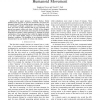64 search results - page 5 / 13 » A model of force and impedance in human arm movements |
NIPS
2001
13 years 9 months ago
2001
Tangential hand velocity profiles of rapid human arm movements often appear as sequences of several bell-shaped acceleration-deceleration phases called submovements or movement un...
ICRA
2005
IEEE
14 years 1 months ago
2005
IEEE
— In many studies and applications that include direct human involvement such as human-robot interaction, control of prosthetic arms, and human factor studies, hand force is need...
JIRS
2006
13 years 7 months ago
2006
The paper considers a technique for computation of the inverse kinematic model of the human arm. The approach is based on measurements of the hand position and orientation as well ...
HAPTICS
2010
IEEE
13 years 5 months ago
2010
IEEE
Time delay in haptic telepresence arising from compression or communication alters the phase characteristics of the environment impedance. This paper describes how well a human ope...
IROS
2006
IEEE
14 years 1 months ago
2006
IEEE
— This paper proposes a Hidden Markov Model (HMM) based approach to generate human-like movements for humanoid robots. Given human motion capture data for a class of movements, p...

